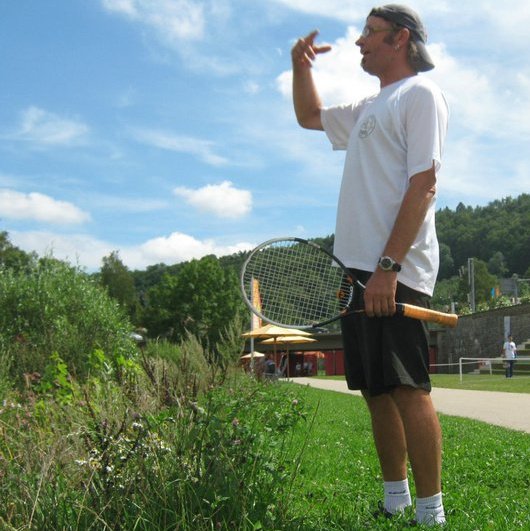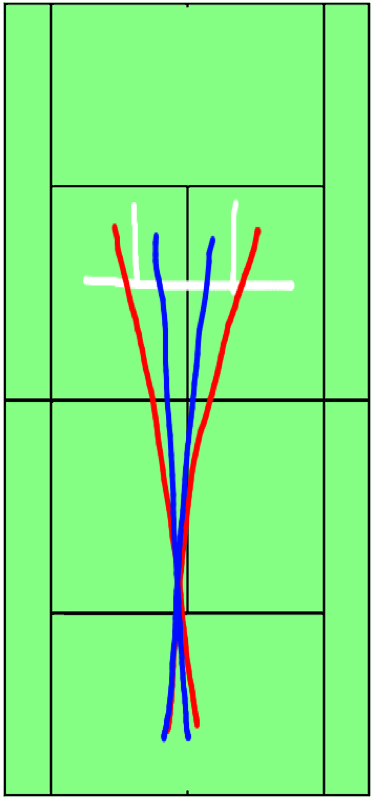There are a few pieces of advice that get passed down from generation to generation and one of them happens to "don't play in no-man's land" or "don't get stuck in no man's land". Although I agree with the theory behind these concepts - after all, the closer to the court you are, the faster you need to be and the better your balance (in addition to the risk of being struck "in the shoe-laces) - I completely disagree with the concept that one should not know how to play from inside the baseline entirely.
No man's land is a transition area and if you're no comfortable in that part of the court, the chance that you will be comfortable coming in (to the net) is very small. One of my pet peeves is seeing players practice from 2, 3, 5 or 10 feet behind the baseline where they look like world-class tennis players. Then, they move in and practice volleys from 6 feet from the net....completely ignoring the 400 square feet of court in between. Let me dispel one myth right off the bat: the chance that you are going to hit a shot (bet it serve or groundstroke) from behind the baseline and then be able to make contact with the volley 6 feet from the net is extremely small...either the opponent isn't very good or you hit a very fortunate shot.
The vast majority of first volleys are really encountered around the service line (maybe a bit behind it). But if you're not confident that you can handle this no man's land zone, the likelihood that you will be confident in making the journey to the net is very small. That's primarily because if opponents don't hit outright winners, they can usually dip the ball with heavy spin or hit a slice that grazes the net (forcing you to make contact from further back than you're used to).
As a baseline player (which most players happen to be), it is important to become comfortable in this transition area (from 1 foot inside the baseline to 1 foot behind the service line) because you never know when the play calls for coming in and you don't want to hesitate or second guess yourself. It is sometimes amusing to see coaches yelling at players (with proverbial steam coming out of their ears) for not following the ball in. They never bother asking the question why the player did not do so. Often times the answer is "because I'm not confident in the mid-court", You can practice volleys until you're blue in the face, but if you don't know how to handle the transition area, you will simply not come in at all the right times...and God forbid that the opponent happens to pass you the first time out. That's when junior say "check please" and keep on staying back, pounding groundies.
Listen, if you want to improve your net game, you have to start it one step at a time. In a previous tip, we mentioned how you should see the court as a chess-board with 3x3ft squares. In reality, try seeing it as a Rubiks cube that is made up of smaller 3x3x3ft cubes. These "cubes": are on your side of the court as well as your opponents. You should strive to master hitting any "cube" on your opponent's side of the court FROM any cube on your side of the court where the ball happens to be...and a lot of these "cubes" happen to be in the mid court. Therefore, swinging volleys, regular volleys, pick-up/half-volleys, abbreviated swing groundstrokes, bunts, high backhand "overheads", skyhooks, etc. all have to be practiced. Any player who is comfortable hitting these shots from mid-court will have more confidence in going in "all the way". It's really the fear of missing or getting passed (something that doesn't happen a lot from the baseline) that holds the players back.
Therefore, do drills where you are mixing baseline shots, with swinging volleys, with pick-ups and regular volleys so that you know what you have to do if you don't happen to hit your first volley from on top of the net. In other words, get comfortable coming in in stages, and then try to have fewer and fewer stages. In your mind, you should have the belief in yourself that if the ball bounces a foot from the baseline you can handle it ("I got this") and know exactly where and how your shot should be hit.
 Wednesday, December 21, 2011 at 11:27AM
Wednesday, December 21, 2011 at 11:27AM  CAtennis
CAtennis  This drill comes to us from Mr. Frercks Hartwig who is currently associated as a tennis coach and player devepoler at TMS - Die mobile Tennisschule in Baden-Wurttemberg, Germany.
This drill comes to us from Mr. Frercks Hartwig who is currently associated as a tennis coach and player devepoler at TMS - Die mobile Tennisschule in Baden-Wurttemberg, Germany.

